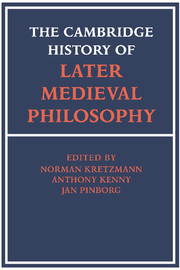 The Cambridge History of Later Medieval Philosophy
The Cambridge History of Later Medieval Philosophy from IV - Logic in the high middle ages: semantic theory
Published online by Cambridge University Press: 28 March 2008
Grammar in the early Middle Ages
Medieval speculative grammar grew out of the schoolmens' work with ancient Latin grammar as it had been transmitted in the canonical works of Donatus and Priscian. The efforts of early medieval glossators were directed towards explaining the authoritative texts, towards systematising the descriptional apparatus used by the authors, and towards harmonising the apparent or real contradictions which arose in a comparison of the grammatical and logical traditions. The results of their combined efforts were summarised in the famous Summa super Priscianum compiled about 1140 by Peter Helias. The grammarians' discussions, which had been influenced by the logicians, in their turn influenced and refined logical doctrine and played an important role in the emergence of the specifically medieval logical doctrines known collectively as terminist logic. The grammatical discussions about the meaning of substantive words, for instance, were crucial to the development of the theory of supposition. The twelfth-century grammarians emphasised the importance of explaining linguistic features causally, instead of just describing them as Priscian had done, and in this way attained a high degree of linguistic sophistication. But it would perhaps be too much to say that their efforts already inaugurated a new paradigm of linguistic description.
The general nature of ‘modistic’ grammar
Around 1270, however, a new theoretical framework was established. The phases of the development which brought this about are not yet known in detail, but the first representatives of the new doctrine seem to be Boethius of Dacia and Martin of Dacia.
To save this book to your Kindle, first ensure no-reply@cambridge.org is added to your Approved Personal Document E-mail List under your Personal Document Settings on the Manage Your Content and Devices page of your Amazon account. Then enter the ‘name’ part of your Kindle email address below. Find out more about saving to your Kindle.
Note you can select to save to either the @free.kindle.com or @kindle.com variations. ‘@free.kindle.com’ emails are free but can only be saved to your device when it is connected to wi-fi. ‘@kindle.com’ emails can be delivered even when you are not connected to wi-fi, but note that service fees apply.
Find out more about the Kindle Personal Document Service.
To save content items to your account, please confirm that you agree to abide by our usage policies. If this is the first time you use this feature, you will be asked to authorise Cambridge Core to connect with your account. Find out more about saving content to Dropbox.
To save content items to your account, please confirm that you agree to abide by our usage policies. If this is the first time you use this feature, you will be asked to authorise Cambridge Core to connect with your account. Find out more about saving content to Google Drive.